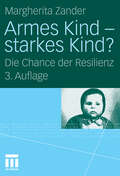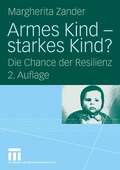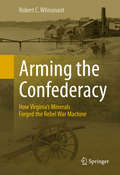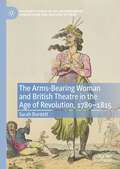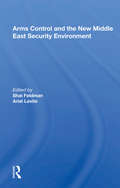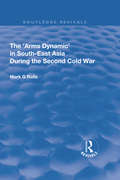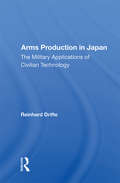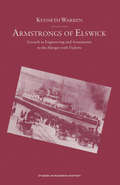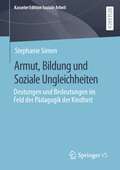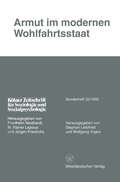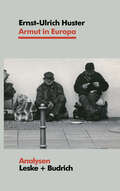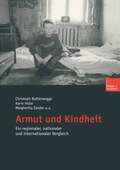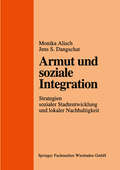- Table View
- List View
Armes Kind - starkes Kind?: Die Chance der Resilienz
by Margherita ZanderDas Buch bietet einen fundierten Einblick in die international viel diskutierte und neuerdings auch in Deutschland lebhaft verfolgte Resilienzforschung. „Resilienz“ bedeutet „seelische Widerstandsfähigkeit“ in belasteten und risikobehafteten Lebenssituationen. Aufwachsen in Armut ist ein zentrales Entwicklungsrisiko für Kinder. Wichtigste Erkenntnis ist, dass „Resilienz“ durch pädagogisches und sozialpädagogisches Handeln gefördert werden kann. Bisher fehlte jedoch eine theoretisch fundierte Begründung und eine substanzielle fachliche Erörterung, wie sich das Resilienzkonzept für Kinder und Familien in Armutslagen übertragen und anwenden lässt. Diese Lücke schließt das Buch.
Armes Kind - starkes Kind?: Die Chance der Resilienz
by Margherita ZanderDas Buch bietet einen fundierten Einblick in die international viel diskutierte und neuerdings auch in Deutschland lebhaft verfolgte Resilienzforschung. „Resilienz“ bedeutet „seelische Widerstandsfähigkeit“ in belasteten und risikobehafteten Lebenssituationen. Aufwachsen in Armut ist ein zentrales Entwicklungsrisiko für Kinder. Wichtigste Erkenntnis ist, dass „Resilienz“ durch pädagogisches und sozialpädagogisches Handeln gefördert werden kann. Bisher fehlte jedoch eine theoretisch fundierte Begründung und eine substanzielle fachliche Erörterung, wie sich das Resilienzkonzept für Kinder und Familien in Armutslagen übertragen und anwenden lässt. Diese Lücke schließt das Buch.
Armies of the Poor: Determinants of Working-class Participation in in the Parisian Insurrection of June 1848
by Mark TraugottIn June 1848, two irregular armies of the urban poor fought a four-day battle in the streets of Paris that decided the fate of the French Second Republic. The Parisian National Workshops and the Parisian Mobile Guard-organizations newly created at the time of the February Revolution-provided the bulk of the June combatants associated with the insurrection and repression, respectively. According to Marx's simple and compelling hypothesis, a nascent French proletariat unsuccessfully attempted to assert its political and social rights against a coalition of the bourgeoisie and lumpenproletariat, represented by the Parisian Mobile Guard. Through a detailed study of archival sources, Mark Traugott challenges this interpretation of these events and proposes an organizational explanation.Research has consistently shown that skilled artisans and not unskilled proletarians stood at the forefront of the revolutionary struggles of the nineteenth century. Traugott compares the social identities of the main participants on opposite sides of the conflict and sorts out the reasons for the political alignments observed. Drawing on work by Charles Tilly and Lynn Lees, Traugott demonstrates that the insurgents were not highly proletarianized workers, but rather members of the highly skilled trades predominant in the Parisian economy. Meanwhile, those who spearheaded the repression were little different in occupational status, though they tended to be significantly younger. Traugott's ""organizational hypothesis"" makes sense of the observed configuration of forces. He accounts for the age differential as a by-product of the recruitment criteria that Mobile Guard volunteers were required to meet. Finally, he explains why class position creates no more than a diffuse political predisposition that remains subject to the influence of situation-specific factors such as organizational affiliations. Armies of the Poor helps clarify our understanding of the dynamic at work in the insurrectiona
Armies of the Poor: Determinants of Working-class Participation in in the Parisian Insurrection of June 1848
by Mark TraugottIn June 1848, two irregular armies of the urban poor fought a four-day battle in the streets of Paris that decided the fate of the French Second Republic. The Parisian National Workshops and the Parisian Mobile Guard-organizations newly created at the time of the February Revolution-provided the bulk of the June combatants associated with the insurrection and repression, respectively. According to Marx's simple and compelling hypothesis, a nascent French proletariat unsuccessfully attempted to assert its political and social rights against a coalition of the bourgeoisie and lumpenproletariat, represented by the Parisian Mobile Guard. Through a detailed study of archival sources, Mark Traugott challenges this interpretation of these events and proposes an organizational explanation.Research has consistently shown that skilled artisans and not unskilled proletarians stood at the forefront of the revolutionary struggles of the nineteenth century. Traugott compares the social identities of the main participants on opposite sides of the conflict and sorts out the reasons for the political alignments observed. Drawing on work by Charles Tilly and Lynn Lees, Traugott demonstrates that the insurgents were not highly proletarianized workers, but rather members of the highly skilled trades predominant in the Parisian economy. Meanwhile, those who spearheaded the repression were little different in occupational status, though they tended to be significantly younger. Traugott's ""organizational hypothesis"" makes sense of the observed configuration of forces. He accounts for the age differential as a by-product of the recruitment criteria that Mobile Guard volunteers were required to meet. Finally, he explains why class position creates no more than a diffuse political predisposition that remains subject to the influence of situation-specific factors such as organizational affiliations. Armies of the Poor helps clarify our understanding of the dynamic at work in the insurrectiona
Arming Asia: Technonationalism and its Impact on Local Defense Industries (Routledge Security in Asia Series)
by Richard BitzingerBitzinger examines the phenomenon of attempted self-reliance in arms production within Asia, and assesses the extent of success in balancing this independence with the growing requirements of next-generation weapons systems. He analyzes China, India, Japan, South Korea, and Southeast Asia. The overarching question in the book is whether self-reliance is a strategically viable solution for development and manufacturing of arms. Given the ever-changing dynamics and increasing demand for sophisticated next-generation weaponry, will these countries be able to individually sustain their domestic defense industries and constantly update their technologies? This is the first book to analyze arms production from a regional perspective.
Arming Asia: Technonationalism and its Impact on Local Defense Industries (Routledge Security in Asia Series)
by Richard BitzingerBitzinger examines the phenomenon of attempted self-reliance in arms production within Asia, and assesses the extent of success in balancing this independence with the growing requirements of next-generation weapons systems. He analyzes China, India, Japan, South Korea, and Southeast Asia. The overarching question in the book is whether self-reliance is a strategically viable solution for development and manufacturing of arms. Given the ever-changing dynamics and increasing demand for sophisticated next-generation weaponry, will these countries be able to individually sustain their domestic defense industries and constantly update their technologies? This is the first book to analyze arms production from a regional perspective.
Arming the Confederacy: How Virginia’s Minerals Forged the Rebel War Machine
by Robert C. WhisonantThis is a fresh look at the American Civil War from the standpoint of the natural resources necessary to keep the armies in the field. This story of the links between minerals, topography, and the war in western Virginia now comes to light in a way that enhances our understanding of America’s greatest trial. Five mineral products – niter, lead, salt, iron, and coal – were absolutely essential to wage war in the 1860s. For the armies of the South, those resources were concentrated in the remote Appalachian highlands of southwestern Virginia. From the beginning of the war, the Union knew that the key to victory was the destruction or occupation of the mines, furnaces, and forges located there, as well as the railroad that moved the resources to where they were desperately needed. To achieve this, Federal forces repeatedly advanced into the treacherous mountainous terrain to fight some of the most savage battles of the War.
Arms And Politics In The Dominican Republic
by G. Pope AtkinsThis chronicle and interpretation of recent military and political events in the Dominican Republic analyzes the political behavior of the country's armed forces and scrutinizes policies put in action since the nation's civil war and the subsequent U.S. intervention of 1965.
Arms And Politics In The Dominican Republic
by G. Pope AtkinsThis chronicle and interpretation of recent military and political events in the Dominican Republic analyzes the political behavior of the country's armed forces and scrutinizes policies put in action since the nation's civil war and the subsequent U.S. intervention of 1965.
The Arms-Bearing Woman and British Theatre in the Age of Revolution, 1789-1815 (Palgrave Studies in the Enlightenment, Romanticism and Cultures of Print)
by Sarah BurdettThis book explores shifting representations and receptions of the arms-bearing woman on the British stage during a period in which she comes to stand in Britain as a striking symbol of revolutionary chaos. The book makes a case for viewing the British Romantic theatre as an arena in which the significance of the armed woman is constantly remodelled and reappropriated to fulfil diverse ideological functions. Used to challenge as well as to enforce established notions of sex and gender difference, she is fashioned also as an allegorical tool, serving both to condemn and to champion political and social rebellion at home and abroad. Magnifying heroines who appear on stage wielding pistols, brandishing daggers, thrusting swords, and even firing explosives, the study spotlights the intricate and often surprising ways in which the stage amazon interacts with Anglo-French, Anglo-Irish, Anglo-German, and Anglo-Spanish debates at varying moments across the French revolutionary and Napoleonic campaigns. At the same time, it foregrounds the extent to which new dramatic genres imported from Europe –notably, the German Sturm und Drang and the French-derived melodrama– facilitate possibilities at the turn of the nineteenth century for a refashioned female warrior, whose degree of agency, destructiveness, and heroism surpasses that of her tragic and sentimental predecessors.
Arms Control And The New Middle East Security Environment
by Shai FeldmanThis volume incorporates the talks delivered at a conference on 11 Arms Control and the New Middle East Security Environment, 11 held in Ginosar (Israel) in January 1992. The conference was organized within the framework of the Project on Security and Arms Control in the Middle East conducted by Tel Aviv University's Jaffee Center for Strategic Studies. Some 28 scholars from eight different countries, together with some 30 Israelis, took part in the conference deliberations.
Arms Control And The New Middle East Security Environment
by Shai Feldman Ariel LeviteThis volume incorporates the talks delivered at a conference on 11 Arms Control and the New Middle East Security Environment, 11 held in Ginosar (Israel) in January 1992. The conference was organized within the framework of the Project on Security and Arms Control in the Middle East conducted by Tel Aviv University's Jaffee Center for Strategic Studies. Some 28 scholars from eight different countries, together with some 30 Israelis, took part in the conference deliberations.
Arms Control and Security: The Changing Role of Conventional Arms Control in Europe
by Kevin WrightThis title was first published in 2000: The aim of this text is to explore conventional arms control in Europe. The early chapters provide a primarily historical perspective, looking at the context, foundations, main provisions and institutional structure of the main agreements. The later chapters explore the continuing and likely future roles of the OSCE and NATO in the arms control process. The final chapters examine more contemporary developments by looking at the Adapted CFE Treaty and Vienna Documents agreed at the OSCE Istanbul Summit in November 1998 and the challenges posed to existing arrangements by the changing and emergent security threats that potentially face Europe.
Arms Control and Security: The Changing Role of Conventional Arms Control in Europe
by Kevin WrightThis title was first published in 2000: The aim of this text is to explore conventional arms control in Europe. The early chapters provide a primarily historical perspective, looking at the context, foundations, main provisions and institutional structure of the main agreements. The later chapters explore the continuing and likely future roles of the OSCE and NATO in the arms control process. The final chapters examine more contemporary developments by looking at the Adapted CFE Treaty and Vienna Documents agreed at the OSCE Istanbul Summit in November 1998 and the challenges posed to existing arrangements by the changing and emergent security threats that potentially face Europe.
The Arms Dynamic in South-East Asia During the Second Cold War (Routledge Revivals)
by Mark. G RollsThis title was first publishd in 2002. This work uses the concept of the "arms dynamic" to identify and assess the various factors which influenced arms acquisitions of Southeast Asian states during the second Cold War period from 1979 to 1989, providing an essential basis for understanding contemporary developments. The book provides a comprehensive and systematic explanation of the reasons for arms purchases in SE Asia during the 1980s and aims to fill a gap in the literature by fully exploring arms procurement processes in the region prior to the end of the Cold War.
The Arms Dynamic in South-East Asia During the Second Cold War (Routledge Revivals)
by Mark. G RollsThis title was first publishd in 2002. This work uses the concept of the "arms dynamic" to identify and assess the various factors which influenced arms acquisitions of Southeast Asian states during the second Cold War period from 1979 to 1989, providing an essential basis for understanding contemporary developments. The book provides a comprehensive and systematic explanation of the reasons for arms purchases in SE Asia during the 1980s and aims to fill a gap in the literature by fully exploring arms procurement processes in the region prior to the end of the Cold War.
Arms Production In Japan: The Military Applications Of Civilian Technology
by Reinhard DrifteAlthough Japan's arms industry is still relatively small, significant political, economic, and technological developments indicate its growing importance and pave the way for Japan's increasing involvement in arms production. In this comprehensive study, Dr. Drifte examines both the domestic and international environments that are encouraging Japan
Arms Production In Japan: The Military Applications Of Civilian Technology
by Reinhard DrifteAlthough Japan's arms industry is still relatively small, significant political, economic, and technological developments indicate its growing importance and pave the way for Japan's increasing involvement in arms production. In this comprehensive study, Dr. Drifte examines both the domestic and international environments that are encouraging Japan
Armstrongs of Elswick: Growth In Engineering And Armaments To The Merger With Vickers (Studies in Business History)
by Kenneth WarrenArmstrong, the engineers, armament makers and naval shipbuilders was set up in 1847 by William Armstrong at Elswick, Newcastle-Upon-Tyne. This book analyzes Armstrong's 80 years rise, decline and reorganization, treating it, in some ways, as a case study of British industrial malaise.
Armut, Bildung und Soziale Ungleichheiten: Deutungen und Bedeutungen im Feld der Pädagogik der Kindheit (Kasseler Edition Soziale Arbeit #27)
by Stephanie SimonIn dieser Arbeit werden Deutungen und Bedeutungen Sozialer Ungleichheiten im Feld der Pädagogik der Kindheit und damit verbunden mögliche Zusammenhänge zwischen Bildung und Armut aus der Perspektive pädagogischer Fachkräfte in Kindertageseinrichtungen sowie in wissenschaftlichen Publikationen qualitativ-rekonstruktiv untersucht. Im Zentrum stehen dabei ungleichheitstheoretische, wissenschaftstheoretische sowie professionstheoretische Fragestellungen, denen sich die Autorin über eine reflexive Analyseperspektive nähert. Herausgestellt wird, dass sowohl in der pädagogischen als auch in der wissenschaftlichen Praxis problematische Deutungsangebote in Bezug auf Zusammenhänge zwischen Armut und Bildung existieren, etwa Individualisierungen und Naturalisierungen sozialer Ungleichheiten.
Armut im jungen Erwachsenenalter und der Wandel von Arbeitsmarkt, Wohlfahrtsstaat und Haushalten
by Sebastian LinkSebastian Link geht in diesem Buch der Frage nach, welche Auswirkungen mit dem Erwerbseinstiegsprozess verbundene Risiken (Arbeitslosigkeit, Niedriglohnbeschäftigung) und atypische Beschäftigungsverhältnisse auf die Armutsbetroffenheit junger Erwachsener in Deutschland haben. Mithilfe von Quer- und Längsschnittanalysen auf Basis des Sozio-Oekonomischen Panels zeigt er, dass nicht in erster Linie das gehäufte Auftreten von Erwerbsrisiken und atypischer Beschäftigung zu einem Armutsanstieg bei jungen Erwachsenen geführt hat, sondern die Verstärkung ihrer negativen finanziellen Folgen. Diese Verstärkung steht in einem Zusammenhang mit dem abnehmenden Schutz junger Erwachsener vor Armut durch Wohlfahrtsstaat und Haushalte.
Armut im modernen Wohlfahrtsstaat (Kölner Zeitschrift für Soziologie und Sozialpsychologie Sonderhefte #32)
by Stephan Leibfried Wolfgang VogesArmut und Kindheit: Ein regionaler, nationaler und internationaler Vergleich
by Christoph Butterwegge Karin Holm Barbara Imholz Michael Klundt Caren Michels Uwe Schulz Gisela Wuttke Margherita Zander Matthias ZengIn diesem Band werden Ursachen und Erscheinungsformen von Kinderarmut in Ost- und Westdeutschland, auf dem Land und in der Stadt sowie in der sog. Ersten und Dritten Welt miteinander verglichen. Im Rahmen einer „dualen Armutsforschung“, die sowohl gesellschaftliche Strukturen und subjektive (Kinder-) Perspektiven einfängt als auch der (infantilisierten) Armutsstruktur auf den Grund geht, entwickeln die ForscherInnen bildungs-, familien-, sozial- und entwicklungspolitische Gegenstrategien sowie Konzepte für Soziale Arbeit und Sozialpädagogik.
